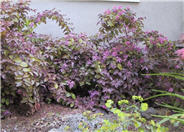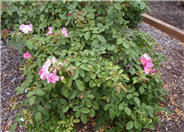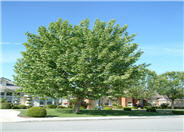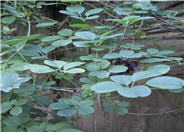
Common name:Chinese Pistache
Botanical name:Pistacia chinensis
The Pistacia chinensis is a deciduous tree with broad, spreading growth to 50' in height. Its leaves have 10-16 leaflets, and the fall coloring arrives in beautiful shades of red, orange and yellow. The young trees are often gawky, but some become shapely with age.

Common name:Red Fringe Flower
Botanical name:Loropetalum chinese 'Rubrum'
Red Fringe Flower is a 6'-12' shrub with arching branches and light green and reddish leaves .

Common name:Butterfly-Iris, Fortnight Lily
Botanical name:Dietes iridioides
This clumping evergreen Iris bears tall, narrow leaves to 30" tall and white flowers marked purple in the center on stalks up to 3' tall. This variety has stiffer, darker foliage than the bicolor form. It requires sun to part shade with little or no summer watering when established. -Monterey Bay Nursery

Common name:Mexican Feather Grass
Botanical name:Nassella tenuissima
This ornamental grass grows to 2' tall. It goes partially dormant during the summer but green in spring and fall. It prefers a sunny, well drained site. This plant can be invasive in some areas, so use caution. To keep reseeding to a minimum, drip irrigation will be best. Cut back in early spring to remove dormant foliage and dried seed heads. It can also tolerate dry shade. It grows to 10" wide and is the finest textured of the ornamental grasses.

Common name:Lamb's Ears
Botanical name:Stachys byzantina
This tiny, herbaceous shrub will grow less than 1' tall and has medium sized, grayish green leaves with blue and lavender flowers that bloom in the spring.

Common name:Shrub Rose
Botanical name:Rosa Shrub varieties
The dark green, heavily veined leaves of this bushy shrub are strong support for the pure white or pink, nearly double flowers it produces. This is a very tolerant, heavily scented plant with an impressive fall color. Also, large hips appear intermittently with this plant.

Common name:California Sycamore
Botanical name:Platanus racemosa
The California Sycamore is a fast growing deciduous tree that reaches up to 40'-50' high. It tolerates heat, smog, as well as moist conditions; it is native to riparian areas. It can be drought tolerant once it's established if there is a high water table. It has interesting mottled bark when the tree is bare in winter. Leaves in fall are gold, red and orange, creating litter. It is beautiful all year round.

Common name:Elija Blue Fescue
Botanical name:Festuca glauca 'Elija Blue'
The 'Elijah Blue' is a dwarf variety with gray blue (but sometimes white-looking) foliage. It should receive sun and little summer watering. -Monterey Bay Nursrey

Common name:Five-Leaf Akebia
Botanical name:Akebia quinata
This vine grows to 20' and bears small, pendant, dark burgundy purple flowers in spring and edible fruit in summer. The three flared, round petals are cup-shaped. It exhibits a delicate, woodsy look with dark green palmate leaves and oval leaflets. This deciduous plant should be grown in sun to part shade and should receive average watering. -Monterey Bay Nursery

Common name:Allepo Pine
Botanical name:Pinus halepensis
The Pinus halepensis exhibits moderate growth to 30' or more, with an open, irregular crown. Mature trees have horizontal spreading branches, 20' wide and more. The needles light green in color, with a length of 2.5"- 4". Flowers are insignificant. Cones appear on the tree after a few years, rounded and oval shaped, about 3" long. Allepo Pine prefers full sun and low watering, although it will drop its needles if water stressed.

Common name:Garden or Common Geranium
Botanical name:Pelargonium X hortorum
Pelargonium X hortorum is a shrubby, succulent perennial stemmed to 3' or more. Round or kidney-shaped leaves are velvety and hairy, soft to the touch, aromatic, with edges distinctly lobed and scalloped toothed. Single and double flowers are flatter and smaller than those of Pelargonium domesticum variety, but clusters bear more blossoms.
| Designer: Unknown | Lots of Interest |
Photographer: GardenSoft |
Soils and Compost:
Incorporate compost 6" into your soil to retain water, reduce compaction, feed earthworms, and provide valuable nutrients to your plants.
Water Saving Tip:
Replace turf with groundcovers, trees, and shrubs. If you have areas where no one uses the grass, patches that do not grow well, or a turf area too small to water without runoff, consider replacing the turf with water-efficient landscaping.
Integrated Pest Management:
Remove irrigation water and fertilizer from areas where you don't want weeds to grow.
